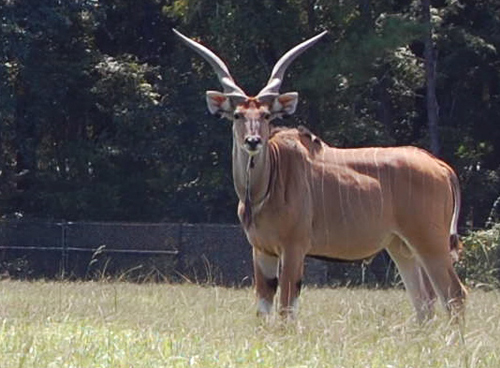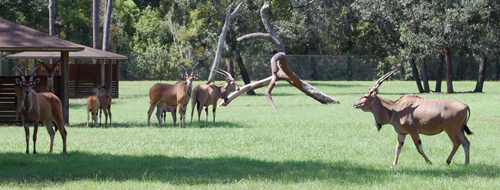Story by Natalie Osborne, a U of G student writer with SPARK (Students Promoting Awareness of Research Knowledge)

A connection between the University and two world-famous wildlife establishments aims to apply a diagnostic tool developed for the dairy industry to solve the digestive problems experienced by wild ruminants living in zoos and conservation parks around the world.
Prof. Brian McBride and postdoc Ousama Alzahal in the Department of Animal and Poultry Science developed the diagnostic technology, called a telemetric bolus, for use in dairy cattle. Now, veterinarian Scott Citino of White Oak Conservation Center and animal nutritionist Eduardo Valdes at Disney’s Animal Kingdom are working together to adapt the telemetric bolus for use in their wild ruminants. They believe the bolus may be able to improve their animals’ health management.
“This may be the first time a device designed for dairy cattle has been applied to wildlife,” says McBride.
The telemetric bolus was designed to monitor sub-acute ruminal acidosis (SARA), a costly digestive disorder common in high-producing dairy cows. The 120-g cylindrical plastic device records continuous temperature readings from inside the cow and transmits them to a field receptor. The receptor then sends the data to a personal computer or cellphone.
McBride and Alzahal were able to correlate ruminal temperature in dairy cows with the acidity of ruminal fluid associated with SARA. They found temperatures of 39-41 C indicate SARA conditions. Citino and Valdes are trying to establish the same relationship for their wild ruminants.
Citino became interested in wild-animal care during his time at veterinary school and a post-graduate position at the National Zoo in Washington, D.C. Now he’s the staff veterinarian at the White Oak Conservation Center, an internationally renowned wildlife breeding, research and training center with projects spanning several continents.
More than 25 species of wild animals are under Citino’s care at the 600-acre conservation centre outside Jacksonville, Fla. He’s seen digestive issues in a variety of antelopes, from the 680 kg giant eland to the tiny, fragile gerenuk.
“Acidosis is a major health concern for wild ruminants living in zoos or conservation parks, says Citino. “We often find pathology in the rumens of deceased animals, which indicates they experienced chronic acidosis over their lifetime. We believe this acidity is the result of an interaction between environmental temperatures and diet.”
But detecting digestive problems in wild animals is difficult. Invasive diagnostic procedures that can stress the animal or compromise its health are avoided. Handling can also stress the animal, something zoos and conservation sites aim to minimize. Often, the diagnosis comes after the animal has died and pathologists have examined their rumen tissue.
“Giant eland living in zoos experience a sharp decline in health around eight years of age; they begin a wasting process that’s difficult to reverse,” says Citino. “Rumen acidity is often associated with this wasting, and diagnosing it early could mean prolonging the health and life of these animals.”
So far, the boluses have been placed in two female giant eland at White Oak, and the researchers plan to monitor them over several seasons to get an average for summer and winter readings, and to determine if season and diet have an effect on ruminal temperature.
Properly feeding a wild animal can be difficult. In many cases, the natural diets are either unknown, partially understood or difficult to provide in a zoo setting.
That’s where Valdes, a Guelph alumnus and wildlife nutrition specialist, comes in. After emigrating from Chile, he began his work with wild animals as a keeper at the Toronto Zoo. Now he’s working as the head nutritionist at Disney’s Animal Kingdom, where he and his team provide the diets for approximately 250 species, from reptiles and birds to large carnivores and browsers like the eland.
Valdes combines his own formulations with resort-grown exotic vegetation to tailor diets specifically to each animal. “It’s difficult to mimic the natural diet for any wild animal,” says Valdes. “Browsers like the eland or gerenuk are a special challenge because they eat small amounts spread out over the day, feeding on a wide variety of vegetation. In zoos or conservation parks, they are fed a few larger meals each day, and this type of feeding can contribute to the stress on their digestive tracts.”
Traditional zoo diets for herbivores were based on those for production animals, such as beef or dairy cows. Production diets were designed to maximize milk production or weight gain, whereas the goal of wild-animal nutrition is to maintain and conserve animals for as long as possible.
Valdes plans to use the telemetric bolus to monitor the effects of different diets, running the extremes from high to low starch. As well, he says, the telemetric bolus may also be able to tell researchers when a female is entering heat, or when an animal has a fever caused by some other infection. “If we can find the diagnostic relationship, it would be a wonderful tool to use in the Disney Animal Kingdom to help us maintain and improve our animals’ health and well-being.”
Funding for the telemetry research with dairy cows at the University of Guelph was provided by the Dairy Farmers of Canada and the Natural Sciences and Engineering Research Council.
